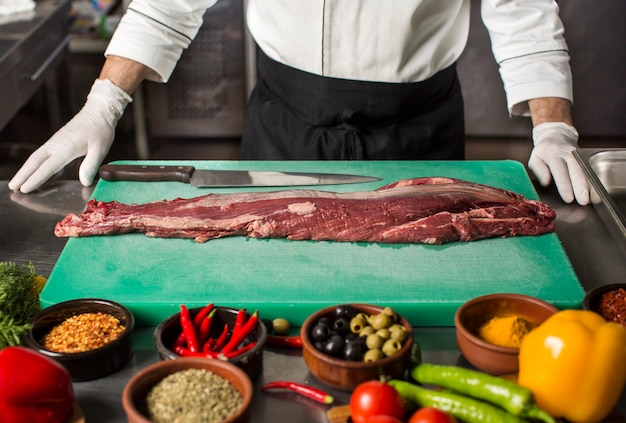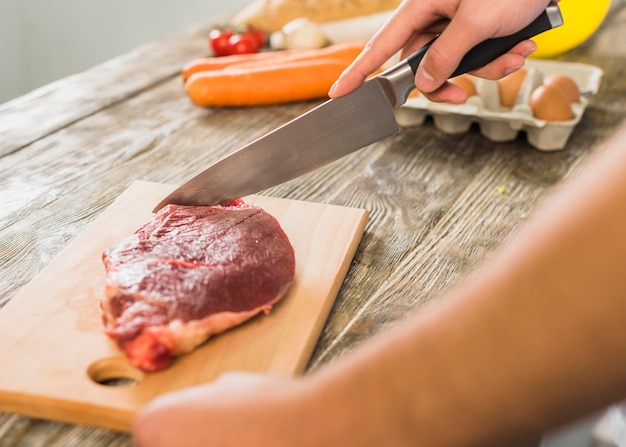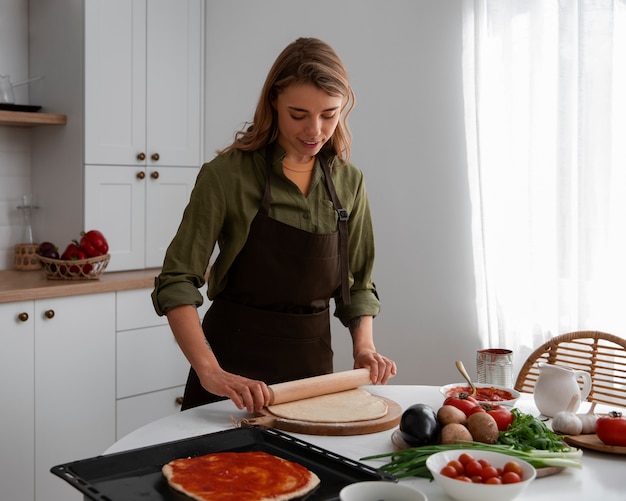Let’s talk about beef skirt steak. It’s a cut of meat that often gets overlooked, but it’s actually one of the most flavorful and versatile cuts you can find. I’ve been cooking skirt steak for years, and I’ve learned a thing or two about how to get it perfectly tender and juicy. Whether you’re a seasoned pro or a complete beginner, this guide will walk you through everything you need to know. Buckle up, it's a delicious journey!
Part 1: Getting to Know Skirt Steak

Understanding the Cut
First things first, let’s break down what exactly skirt steak is. It’s a long, thin cut of beef that comes from the diaphragm muscle of the cow. Think of it as the "muscle" that helps the cow breathe. It’s a very lean cut of meat, meaning it has less fat than other cuts like ribeye or sirloin. This can be a good thing because it means it's lower in calories, but it also means it can be a bit tougher if you’re not careful. This is where the magic of proper cooking comes in!
Why Skirt Steak is a Winner
Despite its tendency to be a bit chewy, skirt steak has a rich, beefy flavor that’s simply unbeatable. It’s also a great value for your money, as it’s typically less expensive than other cuts of steak. Who doesn’t love a good bargain, right? Plus, it’s a blank canvas for flavor. The possibilities are endless. Think marinades, rubs, sauces - you can truly make it your own.
Choosing the Right Skirt Steak
Now, when you’re at the butcher’s counter, you’ll find two main types of skirt steak: inside skirt and outside skirt. Think of them like siblings - they share some traits but have unique characteristics. The inside skirt is a bit thicker and more tender than the outside skirt, but it’s also usually more expensive. It’s the "fancy" sibling, if you will. If you’re looking for the best bang for your buck, go for the outside skirt - just be sure to cook it properly to ensure tenderness. It’s the "down-to-earth" sibling that packs a punch in flavor. When choosing your steak, look for a piece that’s brightly coloured and has a good amount of marbling. This indicates a juicy and flavorful steak. Avoid any steaks that look dry or have an off-colour.
Part 2: Preparing Skirt Steak for Success

Get Your Tools Ready
Before you even think about firing up the grill or pan, gather your tools. You’ll need:
- A sharp knife – we're talking about a good chef's knife or a butcher knife, not a blunt butter knife. You'll be making a few cuts to remove the membrane and maybe even trim off some excess fat. A sharp knife makes the job easier and prevents any unnecessary frustration.
- A cutting board – a sturdy one that's not going to slip around. You want your cutting board to be a stable platform for your work, especially when dealing with a sharp knife. We don't want any accidents here.
- Tongs – for safely flipping your steak and grabbing it off the heat. Remember those tongs you never use? Time to give them some love! They're essential for handling hot steak without burning yourself.
- A meat thermometer – a must-have for ensuring that your steak is cooked to your liking. You want to make sure that it’s safe to eat and doesn’t end up too tough. This little tool is a lifesaver when it comes to achieving the perfect level of doneness.
Marinating Magic
Marinating your skirt steak is a great way to boost the flavor and tenderize it. It’s not mandatory, but it certainly makes a difference. Think of it as a spa day for your steak. A simple marinade of olive oil, balsamic vinegar, garlic, and herbs like rosemary or thyme will do wonders. You can also get creative with your marinades, adding things like soy sauce, chili flakes, or citrus juice. Let your imagination run wild! The key is to marinate for at least an hour, or even better, overnight. This lets the flavors seep into the meat and break down the tough muscle fibers, leading to a more tender and flavorful steak.
Trimming for Tenderness
Now, let’s talk about trimming. Skirt steak often has a bit of a membrane on one side, which is a tough, silvery layer that needs to go. It’s like a protective film that keeps the steak intact, but it doesn’t contribute to the flavor or texture. You can trim it off with a sharp knife. Don't be afraid to get rid of any excess fat as well. You want your steak to cook evenly, and removing the membrane and excess fat will help with that. However, remember that a little fat is good, so don’t overdo the trimming. You can even use the trimmings in your marinade for extra flavour. Talk about recycling!
Tenderizing Tips
If you're really concerned about your skirt steak being tough, there are a few more things you can do to tenderize it. You can use a meat mallet to pound it flat, which will break down the muscle fibers. Think of it as giving the steak a gentle massage. You can also try using a marinade that contains an enzyme like pineapple juice or papaya. These enzymes help to break down the proteins in the meat, making it more tender. It's like a natural tenderizer. Just make sure to use these methods in moderation, as too much can make the steak mushy. You want a tender steak, not a mushy one!
Part 3: Cooking the perfect skirt steak

Grilling Glory
The classic way to cook skirt steak is on the grill. This method gives it a beautiful char and a smoky flavour. It’s a truly satisfying experience. First, preheat your grill to high heat. This is important to get a good sear and cook the steak quickly. You want that beautiful caramelized crust that’s the hallmark of a perfectly grilled steak. You'll know it's ready when the grill grates are nice and hot. If you're using a gas grill, you might want to use the high heat setting and close the lid to make it hotter. When it's ready, remove any excess marinade from the steak and place it directly on the hot grill. Cook for 2-3 minutes per side, or until it's nicely seared and has a good char. Then, reduce the heat to medium and cook for another 3-4 minutes per side, or until the steak reaches an internal temperature of 130°F (54°C) for medium-rare. Remember, you want to cook it quickly, so don’t mess with it too much! It should be seared and juicy.
Pan-Seared Perfection
Don't have a grill? No problem! You can also cook skirt steak in a pan. Heat a large cast iron skillet over high heat, then add a tablespoon or two of olive oil. When the oil starts to shimmer, carefully place the steak in the hot pan. Cook for 2-3 minutes per side, or until it's nicely seared and has a good char. Then, reduce the heat to medium and cook for another 3-4 minutes per side, or until the steak reaches an internal temperature of 130°F (54°C) for medium-rare. For a bit more flavour, you can deglaze the pan with a little red wine or beef broth after cooking the steak. This will create a delicious sauce that you can drizzle over the steak. It’s like an extra layer of flavour heaven!
Other Cooking Methods
You can even cook skirt steak in the oven. Preheat your oven to 400°F (200°C). Place the steak on a baking sheet lined with foil and cook for 10-12 minutes, or until it reaches an internal temperature of 130°F (54°C) for medium-rare. This method is great for when you want to cook a few steaks at once. It's a bit more hands-off and ideal for busy weeknights.
Part 4: Mastering the Art of Resting
Once your skirt steak is cooked, don’t be tempted to slice it straight away. Let it rest for 5-10 minutes before carving it up. This will allow the juices to redistribute throughout the meat, resulting in a more tender and flavorful steak. It’s like giving the steak a chance to unwind and recover from the cooking process. While it’s resting, you can make your favorite side dish or sauce. It's like a little break for the steak – and for you.
Part 5: Slicing and Serving Skirt Steak
After resting, it’s time to slice the steak. You’ll want to slice it against the grain, which means slicing across the muscle fibers. This will help make it more tender. If you slice it with the grain, you’ll end up with a tough, chewy steak. A sharp knife is your best friend here. You can slice it into thin strips or thicker slices, depending on your preference.
Part 6: Creating the Perfect Pairings
Now, let’s talk about the sides! Skirt steak is so versatile, it goes well with a wide variety of side dishes. Here are a few of my favorites:
- Roasted vegetables: Asparagus, broccoli, bell peppers, or zucchini are all great options. Roasted vegetables add a nice sweetness and balance to the steak's savory flavor. The char on the vegetables also complements the char on the steak, creating a cohesive and satisfying meal.
- grilled corn: Grilled corn on the cob adds a touch of sweetness and smoky flavor that complements the steak perfectly. It’s a classic combination that never fails to impress.
- mashed potatoes: Classic mashed potatoes are a comforting and satisfying side dish. They soak up all the delicious juices from the steak, adding an extra layer of flavor and richness. Plus, they’re a crowd-pleaser.
- Salad: A fresh salad adds a light and refreshing touch to the meal. I like to use a simple vinaigrette or a lemon-herb dressing. It’s a perfect way to cleanse the palate between bites of steak.
Part 7: Sauces to Elevate Your Steak
A good sauce can really take your skirt steak to the next level. Here are a few sauce ideas to try:
- chimichurri sauce: This Argentine sauce is made with fresh herbs, olive oil, vinegar, and garlic. It’s incredibly flavorful and adds a bright, herbaceous touch to the steak. It’s a great option for those who like a burst of fresh flavor.
- béarnaise sauce: A classic French sauce, béarnaise is rich and creamy, made with egg yolks, butter, and tarragon. It’s a luxurious pairing for steak. It adds a touch of elegance and sophistication to any meal.
- red wine sauce: A simple red wine sauce made with red wine, beef broth, and shallots is always a good choice. It’s savory and robust, and complements the steak beautifully. The depth of flavor from the red wine really elevates the steak.
- peppercorn sauce: For a bit of heat, try a peppercorn sauce. It’s made with black peppercorns, butter, and cream. It adds a nice kick to the steak. It’s a perfect choice for those who like a little spice in their life.
Part 8: Beyond the Plate: Skirt Steak Inspiration
Skirt steak isn’t just for grilling or pan-frying. It’s also great for:
- Tacos: Skirt steak is a staple in tacos. It’s flavorful, tender, and holds up well to all the other toppings. It's a great choice for a quick and satisfying meal.
- Stir-fries: Slice skirt steak into thin strips and toss it into your favorite stir-fry. It’s a quick and easy way to add protein to your meal. It adds a savory flavor and a bit of texture to your stir-fry.
- Salads: Add some grilled or seared skirt steak to a salad for a hearty and flavorful meal. It's a great way to add protein and a smoky flavor to your salad.
- Sandwiches: Make a delicious steak sandwich by grilling or pan-frying skirt steak and topping it with your favorite fixings. It’s a classic combination that’s sure to please.
Part 9: FAQs: All Your Skirt Steak Questions Answered
You’ve got questions, I’ve got answers. Let’s dive into some frequently asked questions about this fantastic cut of meat.
1. How do I know when my skirt steak is cooked to the right temperature?
The best way to tell if your skirt steak is cooked to the right temperature is to use a meat thermometer. Insert the thermometer into the thickest part of the steak and make sure it’s not touching any bone. Here’s a handy table to guide you:
| Doneness | Internal Temperature |
|---|---|
| Rare | 125°F (52°C) |
| Medium-rare | 130°F (54°C) |
| Medium | 140°F (60°C) |
| Medium-well | 150°F (65°C) |
| Well-done | 160°F (71°C) |
2. Can I eat skirt steak if it’s a bit tough?
Yes, you can eat skirt steak even if it’s a bit tough. It might not be as tender as other cuts of meat, but it’s still flavorful. You can try slicing it thinly against the grain to make it easier to chew. And remember, sauces and toppings can help to mask any toughness. A good sauce can go a long way! It's all about finding ways to enhance the eating experience, even if the texture isn't perfect.
3. How long can I keep skirt steak in the fridge?
Skirt steak can be kept in the fridge for 3-5 days. Be sure to store it in an airtight container or wrap it tightly in plastic wrap. This will help prevent it from drying out. It's best to use it within that timeframe to ensure the best quality.
4. What’s the best way to reheat skirt steak?
The best way to reheat skirt steak is in the oven. Preheat your oven to 350°F (175°C). Place the steak on a baking sheet and reheat for 5-10 minutes, or until it’s heated through. You can also reheat it in a skillet over medium heat, but be careful not to overcook it. The key is to reheat it gently to avoid drying it out.
5. What are some tips for making skirt steak more tender?
Here are a few tips for making skirt steak more tender:
- Marinate it: Marinating skirt steak in an acidic marinade, like one with vinegar or citrus juice, will help to break down the tough muscle fibers and make it more tender. Think of it as a natural tenderizer. The longer you marinate it, the more tender it will be.
- Tenderize it: You can use a meat mallet to pound the steak flat, which will also help to break down the muscle fibers. It's like giving the steak a gentle massage. This is especially useful for outside skirt, which is naturally tougher.
- Cook it quickly: Skirt steak is best cooked quickly over high heat. This will help to seal in the juices and prevent it from becoming tough. The key is to sear it quickly to create a flavorful crust and then cook it to the desired temperature.
- Let it rest: After cooking, let the steak rest for 5-10 minutes before slicing it. This will allow the juices to redistribute and make it more tender. It’s a crucial step for any steak, but especially important for skirt steak.
- Slice it against the grain: Slicing skirt steak against the grain will help to make it more tender. It’s like cutting the muscle fibers, making them easier to chew.
I hope this guide has helped you to understand the ins and outs of cooking beef skirt steak. It's a fantastic cut of meat that's both flavorful and affordable. With a little bit of practice, you'll be able to cook it perfectly every time. So, go forth, get your hands on some skirt steak, and enjoy!
Everyone is watching

Prime Rib Roast Cooking Time Chart: Per Pound Guide
Cooking TipsPrime rib roast. Just the name conjures images of lavish dinners, crackling fires, and hearty laughter. It’s ...

How Long to Bake Potatoes in the Oven (Perfect Every Time)
Cooking TipsBaked potatoes are a staple in my kitchen. They're incredibly versatile, delicious, and surprisingly easy to m...

Perfect Rice Every Time: The Ultimate Guide to Cooking Rice
Cooking TipsAs a self-proclaimed foodie, I've always been a bit obsessed with rice. It's the foundation of countless cuisi...

The Ultimate Guide to Cooking Asparagus: Tips, Techniques, and Recipes
Cooking TipsAsparagus. The mere mention of this spring delicacy conjures up images of vibrant green spears, crisp and burs...

Ultimate Guide to Cooking the Perfect Thanksgiving Turkey
Cooking TipsThanksgiving. Just the word conjures up images of overflowing tables laden with delicious food, the scent of r...
